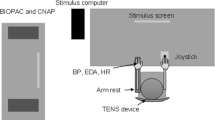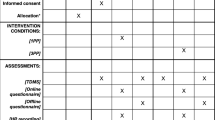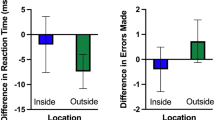Abstract
Recently, virtual environments (VEs) are suggested to encourage users to exercise regularly. The benefits of chronic exercise on cognitive performance are well documented in non-VE neurophysiological and behavioural studies. Based on event-related potentials (ERP) such as the N200 and P300, cognitive processing may be interpreted on a neuronal level. However, exercise-related neuroelectric adaptation in VE remains widely unclear and thus characterizes the primary aim of the present study. Twenty-two healthy participants performed active (moderate cycling exercise) and passive (no exercise) sessions in three VEs (control, front, surround), each generating a different sense of presence. Within sessions, conditions were randomly assigned, each lasting 5 min and including a choice reaction-time task to assess cognitive performance. According to the international 10:20 system, EEG with real-time triggered stimulus onset was recorded, and peaks of N200 and P300 components (amplitude, latency) were exported for analysis. Heart rate was recorded, and sense of presence assessed prior to and following each session and condition. Results revealed an increase in ERP amplitudes (N200: p < 0.001; P300: p < 0.001) and latencies (N200: p < 0.001) that were most pronounced over fronto-central and occipital electrode sites relative to an increased sense of presence (p < 0.001); however, ERP were not modulated by exercise (each p > 0.05). Hypothesized to mirror cognitive processing, decreases of cognitive performance’s accuracy and reaction time failed significance. With respect to previous research, the present neuroelectric adaptation gives reason to believe in compensative neuronal resources that balance demanding cognitive processing in VE to avoid behavioural inefficiency.







Similar content being viewed by others
References
Anderson-Hanley C, Arciero PJ, Brickman AM, Nimon JP, Okuma N, Westen SC, Merz ME, Pence BD, Woods JA, Kramer AF, Zimmerman EA (2012) Exergaming and older adult cognition: a cluster randomized clinical trial. Am J Prev Med 42:109–119. doi:10.1016/j.amepre.2011.10.016
Batson CD, Brady RA, Peters BT, Ploutz-Snyder RJ, Mulavara AP, Cohen HS, Bloomberg JJ (2011) Gait training improves performance in healthy adults exposed to novel sensory discordant conditions. Exp Brain Res 209:515–524. doi:10.1007/s00221-011-2574-6
Baumgartner T, Valko L, Esslen M, Jäncke L (2006) Neural correlate of spatial presence in an arousing and noninteractive virtual reality: an EEG and psychophysiology study. Cyberpsychol Behav 9:30–45
Bishop SJ, Duncan J, Lawrence AD (2004) State anxiety modulation of the amygdala response to unattended threatrelated stimuli. J Neurosci 24:10364–10648
Brümmer V, Schneider S, Strüder HK, Askew CD (2011) Primary motor cortex activity is elevated with incremental exercise intensity. Neuroscience 181:150–162. doi:10.1016/j.neuroscience.2011.02.006
Colcombe SJ, Erickson KI, Scalf PE, Kim JS, Prakash R, McAuley E, Elavsky S, Marquez DX, Hu L, Kramer AF (2006) Aerobic exercise training increases brain volume in aging humans. J Gerontol A Biol Sci Med Sci 61:1166–1170
Collardeau M, Brisswalter J, Audiffren M (2001) Effects of a prolonged run on simple reaction time of well trained runners. Percept Mot Skills 93:679–689
Cuthbert BN, Schupp HT, Bradley MM, Birbaumer N, Lang PJ (2000) Brain potentials in affective picture processing: covariation with autonomic arousal and affective report. Biol Psychol 52:95–111
Davranche K, Audiffren M (2004) Facilitating effects of exercise on information processing. J Sports Sci 22:419–428
Debener S, Minow F, Emkes R, Gandras K, de Vos M (2012) How about taking a low-cost, small, and wireless EEG for a walk? Psychophysiology 49:1449–1453. doi:10.1111/j.1469-8986.2012.01471.x
Duncan CC, Barry RJ, Conolly JF, Fischer C, Michie PT, Näätänen R, Polich J, Reinvang I, van Petten C (2009) Event-related potentials in clinical research: guidelines for eliciting, recording, and quantifying mismatch negativity, P300, and N400. Clin Neurophysiol 120:1883–1908. doi:10.1016/j.clinph.2009.07.045
Fent J, Weisz J (1999) Visual event-related potentials evoked by using a virtual reality display. Acta Physiol Hung 86:45–55
Folstein JR, van Petten C (2008) Influence of cognitive control and mismatch on the N2 component of the ERP: a review. Psychophysiology 45:152–170
Gratton G, Coles MG, Donchin E (1983) A new method for off-line removal of ocular artifact. Electroencephalogr Clin Neurophysiol 55:468–484
Herpers R, Hetmann F, Hau A, Heiden W (2005) The immersion square—a mobile platform for immersive visualizations. In: Hartmann U, Kohl-Bareis M, Hering P, Lonsdale G, Bongartz J, Buzug TM (eds) Aktuelle Methoden der Laser- und Medizinphysik. VDE, Remagen, pp 54–59
Herpers R, Scherfgen D, Kutz M, Bongartz J, Hartmann U, Schulzyk O, Boronas S, Saitov T, Steiner H, Reinert D (2011) Multimedia sensory cue processing in the FIVIS simulation environment. In: Ghinea G, Andres F, Gulliver S (eds) Multiple sensorial media advances and applications: new developments in MulSeMedia. IGI Global, Hershey, pp 217–233
Hillman CH, Pontifex MB, Raine LB, Castelli DM, Hall EE, Kramer AF (2009) The effect of acute treadmill walking on cognitive control and academic achievement in preadolescent children. Neuroscience 159:1044–1054. doi:10.1016/j.neuroscience.2009.01.057
Hoffman HG, Richards T, Coda B, Richards A, Sharar SR (2003) The illusion of presence in immersive virtual reality during an fMRI brain scan. Cyberpsychol Behav 6:127–131
Holden MK (2005) Virtual environments for motor rehabilitation: review. Cyberpsychol Behav 8:187–219
Jasper HH (1958) The ten-twenty electrode system of the international federation. Electroencephalogr Clin Neurophysiol Suppl 35:371–375
Kamijo K, Takeda Y (2009) General physical activity levels influence positive and negative priming effects in young adults. Clin Neurophysiol 120:511–519. doi:10.1016/j.clinph.2008.11.022
Kizony R, Levin MF, Hughey L, Perez C, Fung J (2010) Cognitive load and dual-task performance during locomotion poststroke: a feasibility study using a functional virtual environment. Phys Ther 90:252–260. doi:10.2522/ptj.20090061
Kramer AF, Erickson KI (2007) Capitalizing on cortical plasticity: influence of physical activity on cognition and brain function. Trends Cogn Sci 11:342–348
Kumar N, Sood S, Singh M, Beena S (2010) Effect of acute moderate exercise on cognitive event-related potentials N100, P200, N200, and interpeak latencies. Indian J Psychol Med 32:131–135. doi:10.4103/0253-7176.78511
Ladouceur CD, Dahl RE, Carter CS (2007) Development of action monitoring through adolescence into adulthood: ERP and source localization. Dev Sci 10:874–891
Lewis MD, Lamm C, Segalowitz SJ, Stieben J, Zelazo PD (2006) Neurophysiological correlates of emotion regulation in children and adolescents. J Cog Neurosci 18:430–443
Lewis MD, Todd RM, Honsberger MJM (2007) Event-related potential measures of emotion regulation in early childhood. NeuroReport 18:61–65
Lieberman DA (2009) Designing serious games for learning and health in informal and formal settings. In: Ritterfeld U, Cody M, Vorderer P (eds) Serious games: mechanisms and effects. Routledge, New York, pp 117–130
Öhman A, Flykt A, Esteves F (2001) Emotion drives attention: detecting the snake in the grass. J Exp Psychol Gen 130:466–478
Oloffson JK, Nordin S, Sequeira H, Polich J (2008) Affective picture processing: an integrative review of ERP findings. Biol Psychol 77:247–265. doi:10.1016/j.biopsycho.2007.11.006
Paas FG, Adam JJ (1991) Human information processing during physical exercise. Ergonomics 34:1385–1397
Pelosi L, Holly M, Slade T, Hayward M, Barrett G, Blumhardt LD (1992) Event-related potential (ERP) correlates of performance of intelligence tests. Electroencephalogr Clin Neurophysiol 84:515–520
Pichierri G, Wolf P, Murer K, de Bruin ED (2011) Cognitive and cognitive-motor interventions affecting physical functioning: a systematic review. BMC Geriatr 11:29. doi:10.1186/1471-2318-11-29
Polich J (2007) Updating P300: an integrative theory of P3a and P3b. Clin Neurophysiol 118(10):2128–2148
Polich J, Kok A (1995) Cognitive and biological determinants of P300: an integrative review. Biol Psychol 41:103–146
Pontifex MB, Hillman CH (2007) Neuroelectric and behavioural indices of interference control during acute cycling. Clin Neurophysiol 118:570–580
Ridderinkhof RK, de Vlugt Y, Bramlage A, Spaan M, Elton M, Snel J, Band GP (2002) Alcohol consumption impairs detection of performance errors in mediofrontal cortex. Science 298:2209–2211
Romano DM, Brna P (2001) Presence and reflection in training: support for learning to improve quality decision-making skills under time limitations. Cyberpsychol Behav 4:265–277
Schneider S, Vogt T, Frysch J, Guardiera P, Strüder HK (2009) School sport—a neurophysiological approach. Neurosci Lett 467:131–134. doi:10.1016/j.neulet.2009.10.022
Schneider S, Brümmer V, Carnahan H, Kleinert J, Piacentini MF, Meeusen R, Strüder HK (2010) Exercise as a countermeasure to psycho-physiological deconditioning during long-term confinement. Behav Brain Res 211:208–214. doi:10.1016/j.bbr.2010.03.034
Schupp HT, Junghöfer M, Weike AI, Hamm AO (2004) The selective processing of briefly presented affective pictures: an ERP analysis. Psychophysiology 241:441–449
Themanson JR, Hillman CH (2006) Cardiorespiratory fitness and acute aerobic exercise effects on neuroelectric and behavioural measures of action monitoring. Neuroscience 141(2):757–767
Vogt T, Schneider S, Brümmer V, Strüder HK (2010) Frontal EEG asymmetry: the effects of sustained walking in the elderly. Neurosci Lett 485:134–137. doi:10.1016/j.neulet.2010.09.001
Vogt T, Schneider S, Abeln V, Anneken V, Strüder HK (2012) Exercise, mood and cognitive performance in intellectual disability—a neurophysiological approach. Behav Brain Res 226:473–480. doi:10.1016/j.bbr.2011.10.015
Vogt T, Schneider S, Anneken V, Strüder HK (2013) Moderate cycling exercise enhances neurocognitive processing in adolescents with intellectual and developmental disabilities. Res Dev Disabil 34:2708–2716. doi:10.1016/j.ridd.2013.05.037
Vogt T, Abeln V, Strüder HK, Schneider S (2014) Artificial gravity exposure impairs exercise-related neurophysiological benefits. Physiol Behav 123:156–161
Vuilleumier P, Armony JL, Driver J, Dolan RJ (2001) Effects of attention and emotion on face processing in the human brain an event-related fMRI study. Neuron 30:829–841
Witmer BG, Singer MJ (1998) Measuring presence in virtual environments: a Presence Questionnaire. Presence 7:225–240. doi:10.1162/105474698565686
Yagi Y, Coburn KL, Estes KM, Arruda JE (1999) Effects of aerobic exercise and gender on visual and auditory P300, reaction time, and accuracy. Eur J Appl Physiol 80:402–408
Zanto TP, Gazzaley A (2009) Neural suppression of irrelevant information underlies optimal working memory performance. J Neurosci 29:3059–3066. doi:10.1523/JNEUROSCI.4621-08.2009
Acknowledgments
This study was made possible by research grants from the German Sport University Cologne (HIFF920080) and the Deutsche Gesetzliche Unfallversicherung (FP307). We would like to express our gratitude to all participants who spent their valuable time virtualized in support of this study, to an unknown reviewer for valuable comments to a previous version of this manuscript and further to Timur Saitov for the technical support as well as Sandra Felsner and Amrei Jacubowski for their help during data collection.
Author information
Authors and Affiliations
Corresponding author
Rights and permissions
About this article
Cite this article
Vogt, T., Herpers, R., Scherfgen, D. et al. Neuroelectric adaptations to cognitive processing in virtual environments: an exercise-related approach. Exp Brain Res 233, 1321–1329 (2015). https://doi.org/10.1007/s00221-015-4208-x
Received:
Accepted:
Published:
Issue Date:
DOI: https://doi.org/10.1007/s00221-015-4208-x




